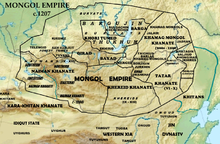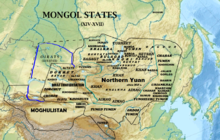
Back Ураҥкай ALT Uraankay Azerbaijani Uriankhai Catalan Urianchajci Czech Urianĥoj Esperanto اوریانخای Persian Uriankhai French Uriankhai ID Urianhaj Italian ウリャンカイ Japanese
 Mongol Empire c 1207, Uriankhai and their neighbours | |
| Regions with significant populations | |
|---|---|
| 26,654 (2010 census)[1] | |
| Languages | |
| Oirat, Mongolian | |
| Religion | |
| Buddhism, Mongolian shamanism, Atheism | |
| Related ethnic groups | |
| Mongols, especially Oirats | |




Uriankhai (traditional Mongolian: ᠤᠷᠢᠶᠠᠩᠬᠠᠢ, Mongolian Cyrillic: урианхай; Yakut: урааҥхай; traditional Chinese: 烏梁海; simplified Chinese: 乌梁海; pinyin: Wūliánghǎi), Uriankhan (ᠤᠷᠢᠶᠠᠩᠬᠠᠨ, урианхан) or Uriankhat (ᠤᠷᠢᠶᠠᠩᠬᠠᠳ, урианхад), is a term of address applied by the Mongols to a group of forest peoples of the North, who include the Turkic-speaking Tuvans and Yakuts, while sometimes it is also applied to the Mongolian-speaking Altai Uriankhai. The Uriankhai included the western forest Uriankhai tribe and the Transbaikal Uriankhai tribe, with the former recorded in Chinese sources as Chinese: 兀良哈; pinyin: Wùliánghā). It is the origin of the Korean term "barbarian", 오랑캐.
© MMXXIII Rich X Search. We shall prevail. All rights reserved. Rich X Search